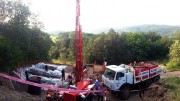Determining executive compensation can be tough enough for a mining company to get right in a normal year, but unique challenges arise as the mining sector begins a rebound.
Executives and the board of directors thinking about pay issues should be aware that a lot has happened in the shareholder community over the past few years.
First, “say on pay” is a reality in the boardroom, regardless of whether there is a formal, non-binding “yes” or “no” vote by shareholders.
While Canada has witnessed a handful of public companies failing a formal say-on-pay vote, Barrick Gold stands out for having failed its vote twice over the past three years. Other mining companies have received votes below 70% support, which doesn’t bode well for mining companies generally.

In March 2016, Barrick Gold cut the pay of executive chairman John Thornton (at right, with Barrick founder Peter Munk in a 2014 photo) by 76% for 2015 in response to shareholder criticism. Credit: Barrick Gold.
Regardless of having a say-on-pay vote or not, the shareholder community is examining the decisions being made on executive compensation under the same methodology.
In lieu of offering a say-on-pay vote, shareholders are now using their right to “withhold” votes for certain individual directors, primarily those that participate on the company’s Compensation Committee, especially if they feel their concerns around pay are not being addressed.
My second point is for mining companies that had a particularly difficult time surviving the weak mining sector in 2014 and 2015. Some of these companies will have completed droves of layoffs, and instilled salary freezes, cutbacks, and anything else to get through the storms.
Now that the rebound is in sight, and the investment community is beginning to release their capital back into the sector, there will be a sense of a need at the executive and board level to “catch up” for the lean years of lower pay.
It is important that the board does not fall into this trap of granting too much equity too quickly to offset the lean years and cause excess equity dilution — a problem that has faced many mining companies in recent years, and will affect the amount of room a company will have to make equity grants in future years.
Moreover, the board needs to properly review executive pay packages amidst the rebound. Those boards that have held the course of continually granting long-term incentive equity over the past few years will likely find themselves in an advantageous position of retention and employee morale.
Those historic low share-price equity grants in 2014 and 2015 are very likely now accruing very motivating wealth gains for executives as their associated vesting schedules unfold.
Those boards who have tightened equity grants over the past few years are unfortunately likely to find themselves reacting to a management team that is starving for a catch-up payment.
The 2016 equity grants are now trending to become performance-based, with the use of Performance Share Units on the rise. The 2016 Global Mining Executive and Board Compensation Survey being published this fall by our firm Global Governance Advisors is showing early evidence of this increased prevalence. These shareholder-friendly equity grants bring complexity in design, granting and monitoring, but they tend to result in a higher pay and performance alignment — which proves for a compelling case when explaining the executive pay program to shareholders.
It’s with the catch-up payment that the shareholder community could turn into a board’s worst nightmare.
In mid-2016, the Ontario Teachers’ Pension Plan, Canada Pension Plan Investment Board and California State Teachers’ Retirement System became vocal about out-of-plan or transaction-oriented awards.
The underlying message to the board is that it should think twice before falling into management’s request of an oversized grant. This isn’t to say a board cannot do such a thing, but it means that if the board has an appropriate business case that requires it to open the corporate wallet more this year than in prior years to offset salary freezes and cutbacks, the shareholder community needs a more robust explanation in the proxy circular.
Our advice is for the board to get out ahead of a potential negative reaction by shareholders. First, the chair of the Compensation Committee needs to engage the shareholder community about compensation. This is a separate meeting where the committee chair may or may not be joined by an independent compensation advisor.
What the committee chair needs to do is inform key shareholders about the business, governance challenges and human capital challenges, including compensation arrangements. This may seem daunting, but the exercise couldn’t be easier today given some of the new technology available to boards that helps identify a company’s shareholders and communicate directly with them.
A company should also be prepared to add a section in the Compensation, Discussion and Analysis section of its proxy circular that summarizes key shareholder concerns, as well as the Compensation Committee’s acknowledgement of the concerns as discussion items and the actions taken against the concerns.
The board needs to start preparing now to review executive bonuses for 2016, especially since they are most likely going to rise. The board should make sure to examine operational, financial and capital market performance on both an absolute and relative level, and let management know it is taking pay seriously and that the board is not waiting for management to negotiate or propose what they believe is the “right” number.
Any such waiting only results in delays and unnecessary conflict. If a board already has a defined scorecard used to measure performance and determine bonus payouts, that’s even better. After reviewing corporate and industry results and speaking with shareholders and management, the Compensation Committee will be in the most advantageous position to finalize 2016 pay and establish market-appropriate long-term incentive grants in 2017.
Mining markets are rebounding fast and without the right process and pay decisions by the board, there is a potential for a groundswell of disgruntled shareholders at the next general meeting.
So boards should get out ahead and ideally start a compensation review in the middle of the fourth quarter.
Executives should be rewarded proportionately with shareholder gains and leading value creation in the short, mid and long terms. The right executive pay design will accomplish this in upward and downward market cycles.
— Based in Toronto, Paul Gryglewicz is a senior partner and independent compensation board advisor at Global Governance Advisors, and oversees Canadian operations. Global Governance Advisors is an independent advisory firm with five offices in Canada and the U.S. that helps organizations with executive compensation, governance, value enhancement and risk mitigation. Please visit ggainc.com for more information.





Be the first to comment on "Commentary: How a board should craft executive pay in a rebounding market"